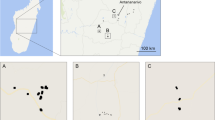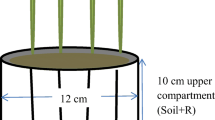Abstract
Isotope dilution techniques were used in a glasshouse experiment to compare seven P sources for oil palm seedlings grown on Rengam series soil (Typic Paleudult). The P sources were triple superphosphate (TSP) and six phosphate rocks from North Carolina, USA (NCPR), Tunisia (Gafsa PR), Jordan (JPR), Morocco (MPR), Christmas Island (CIPR) and China (CPR). The percent P derived from fertilisers (%PdfF) in the 3, 6, 9 and 12 months of growth ranged from 81% to 99%, indicating the poor P supplying power of the soil used. TSP was far superior than PR in supplying the required P at all times of measurement. Total amount of P taken up during the 12 months growing period was equivalent to 15.0% of the added P as TSP, it was 5.2% from NCPR, 4.2% from JPR, 4.1% from MPR, 3.2% from GPR, 4% from CIPR and 2.2% from CPR. The PR effectiveness based on the amounts of fertilizer P taken up by the oil palm seedlings at 12 months of growth was in the sequence of triple superphosphate > North Carolina PR > Gafsa PR ≥ Jordan PR ≥ Morocco PR ≥ Christmas Island PR > China PR. This was due to the reactivity of these P sources when applied into the soil, triple superphosphate being water soluble is immediately available. PR sources reacted with the soil solution with time, making P slowly available. PR solubilised by neutral ammonium citrate (NAC) expressed as percentage of rock was shown to correlate better than 2% citric acid and 2% formic acid with plant P uptake. Thus this method of extracting P from PR can be used as a basis for comparing PR effectiveness to oil palm seedlings.
Similar content being viewed by others
References
Barrow NJ (1974) The slow reaction between soil and anion: 1. Effect of time, temperature and water content of a soil on the decrease in effectiveness of phosphate for plant growth. Soil Sci 118: 380–386
Bolland MDA & Gilkes RJ (1987) How effective are Calciphos and Phosphal. Fert Res 12: 229–239
Chien SH (1995) Chemical, mineralogical and solubility characteristics of phosphate rocks for direct application. In: Dahanayake K et al. (eds) Proc Inter Workshop on Direct Application of Phosphate Rock and Appropriate Technology Fertilisers in Asia: What Hinders Acceptance and Growth, pp 49–58 Inst Fundamental Studies, Sri Lanka and Inter Fert Devt Centre, Muscle Shoal, Alabama, USA
Chien SH & Menon RG (1995) Factors affecting the agronomic effectiveness of phosphate rock for direct application. Fert Res 41: 227–234
Chien SH & Hammond LL (1978) A comparison of various laboratory methods for predicting the agronomic potential of phosphate rocks for direct application. Soil Sci Soc Amer J 42: 935–939
Foong SF (1993) Comparative efficacy of various rock phosphates on the growth of oil palm seedlings using radio-isotope and conventional techniques. 1993 PORIM International Palm Oil Congress, Kuala Lumpur: 625–638
Foster HL, Tarmizi AM, Tayeb MD & Zin ZZ (1988) Oil palm yield responses to P fertiliser in Peninsular Malaysia. PORIM Bull 17: 1–8
Fuad A (1976) Distribution of phosphate in six Malaysian soils. BSc Project Report. University of Malaya, Kuala Lumpur, Malaysia
Ghosh AK & Gilkes RJ (1987) The initial and residual agronomic effectiveness of some Indian, USA and Australian PR. Fert Res 12: 201–218
Goh KJ, Chew PS & Teo CB (1994) Maximising and maintaining oil palm yields on commercial scale in Malaysia. Proc Inter Planters Conf on Management for Enhanced Profitability in Plantations, 1994. Inc Soc Planters, Kuala Lumpur, Malaysia. pp 121–142
Larsen S (1967) Soil phosphorus. Adv Agron 19: 151–120
Larsen S (1952) The use of32P in studies on the uptake of phosphorus by plant. Plant and Soil 4: 1–10
Lehr JR & McClellan GH (1972) A revised reactivity scale for evaluating PR for direct application. Bull Y-43, TVA National Fertiliser Development, Muscle Shoals, Alabama, USA
Ng SK (1986) Phosphorus nutrition and fertilisation of oil palm. Oleagineux 41: 307–313
Owen G (1953) Determination of available nutrients in Malayan soils. J Rub Res Inst Malaya 14: 109–120
Sale PWG & Mokwunye AU (1993) Use of phosphate rocks in the tropics. Fert Res 35: 33–45
Scheel KC (1936) Calorimetric determination of phosphoric acid in fertilisers with the Pulfrich photometer. Zeitschrift für Analytische Chemie 105: 256–269
Smyth FJ & Sanchez A (1982) PR dissolution and availability in Cerrado soils as affected by phosphorus sorption capacity. Soil Sci Soc Am J 46: 339–345
Stephen RC & Condron LM (1986) An assessment of the agronomic efficiency of partially acidulated PR fertilisers. Fert Res 10: 269–282
Zapata F & Axmann H (1995)32P isotopic techniques for evaluating the agronomic effectiveness of rock phosphate materials. Fert Res 41: 189–195
Author information
Authors and Affiliations
Rights and permissions
About this article
Cite this article
Zaharah, A.R., Zulkifli, H. & Sharifuddin, H.A.H. Evaluating the efficacy of various phosphate fertiliser sources for oil palm seedlings. Nutr Cycl Agroecosyst 47, 93–98 (1996). https://doi.org/10.1007/BF01991540
Received:
Accepted:
Issue Date:
DOI: https://doi.org/10.1007/BF01991540




